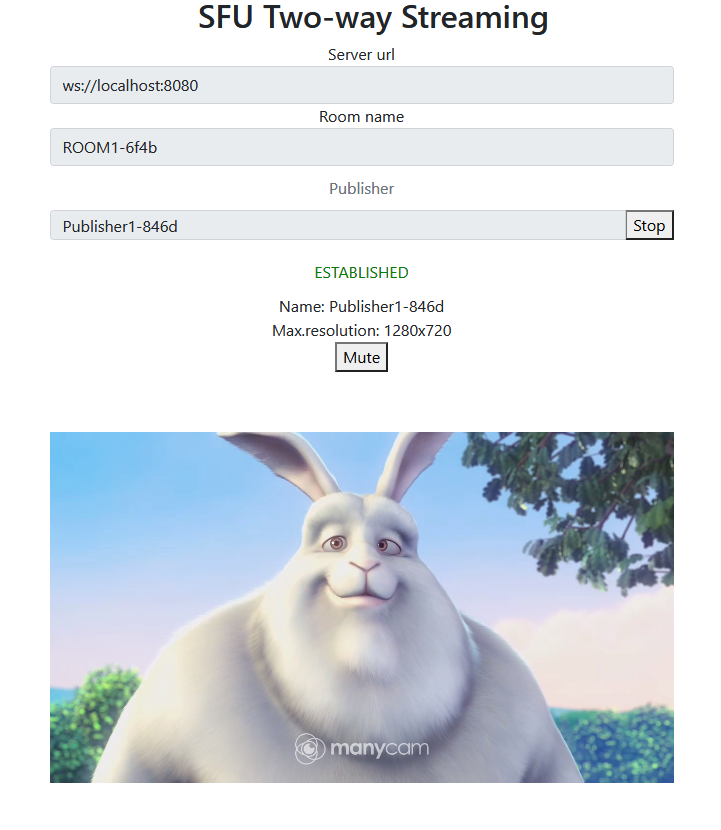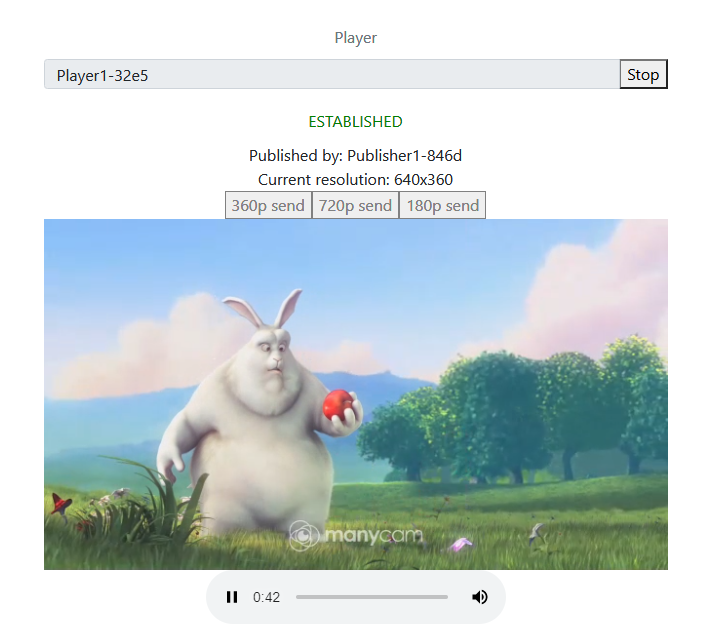The example shows how to publish and play a number of streams in one WebRTC connection with simulcast. A room is considered to be a publishing unit, that is, viewers who connect to this room receive all the streams published in it.
On the screenshots below:
- Server url - Websocket URL of WCS server
- Room name - room name
- Publisher - publisher user name
- Player - viewer user name
- 360p, 720p, 180p send - quality switch buttons
Note that audio tracks are playing in a separate audio tags.
Example source code
To analyze the example source code, take the version available here, which can be downloaded with build 1.0.1.36
The source code consists of the following modules:
- two-way-streaming.html - HTML page
- two-way-streaming.css - HTML page styles
- two-way-streaming.js - main application logic
- config.json - client configuration file, contains streams publishing description
The source code analisys
1. Local variables
Local variables declaration to work with constants, SFU SDK, to display video and to work with client configuration
const constants = SFU.constants; const sfu = SFU; let mainConfig; let localDisplay; let remoteDisplay; let publishState; let playState; const PUBLISH = "publish"; const PLAY = "play"; const STOP = "stop"; const PRELOADER_URL="../commons/media/silence.mp3"
2. Default configuration
Default room configuration and stream publishing configuration to use if there is no config.json file found
const defaultConfig = {
room: {
url: "wss://127.0.0.1:8888",
name: "ROOM1",
pin: "1234",
nickName: "User1"
},
media: {
audio: {
tracks: [
{
source: "mic",
channels: 1
}
]
},
video: {
tracks: [
{
source: "camera",
width: 640,
height: 360,
codec: "H264",
encodings: [
{ rid: "360p", active: true, maxBitrate: 500000 },
{ rid: "180p", active: true, maxBitrate: 200000, scaleResolutionDownBy: 2 }
]
}
]
}
}
};
3. Object to store current publishing/playback state
The object should keep Websocket session data, WebRTC connection data and room data, and shoukd form HTML tags ids to access them from code.
const CurrentState = function(prefix) {
let state = {
prefix: prefix,
pc: null,
session: null,
room: null,
set: function(pc, session, room) {
state.pc = pc;
state.session = session;
state.room = room;
},
clear: function() {
state.room = null;
state.session = null;
state.pc = null;
},
buttonId: function() {
return state.prefix + "Btn";
},
buttonText: function() {
return (state.prefix.charAt(0).toUpperCase() + state.prefix.slice(1));
},
inputId: function() {
return state.prefix + "Name";
},
statusId: function() {
return state.prefix + "Status";
},
formId: function() {
return state.prefix + "Form";
},
errInfoId: function() {
return state.prefix + "ErrorInfo";
},
is: function(value) {
return (prefix === value);
}
};
return state;
}
4. Initialization
init() code
The init() function is called on page load and:
- initializes state objects
- reads
config.jsonfile or default configuration - initializes input fields
const init = function() {
let configName = getUrlParam("config") || "./config.json";
...
publishState = CurrentState(PUBLISH);
playState = CurrentState(PLAY);
$.getJSON(configName, function(cfg){
mainConfig = cfg;
onDisconnected(publishState);
onDisconnected(playState);
}).fail(function(e){
//use default config
console.error("Error reading configuration file " + configName + ": " + e.status + " " + e.statusText)
console.log("Default config will be used");
mainConfig = defaultConfig;
onDisconnected(publishState);
onDisconnected(playState);
});
$("#url").val(setURL());
$("#roomName").val("ROOM1-"+createUUID(4));
$("#publishName").val("Publisher1-"+createUUID(4));
$("#playName").val("Player1-"+createUUID(4));
}
5. Establishing server connection
connect(), SFU.createRoom() code
The connect() function is called by Publish or Play click:
- creates PeerConnection object
- sets up room configuration and creates Websocket session
- subscribes to Websocket session events
const connect = function(state) {
//create peer connection
pc = new RTCPeerConnection();
//get config object for room creation
const roomConfig = getRoomConfig(mainConfig);
roomConfig.pc = pc;
roomConfig.url = $("#url").val();
roomConfig.roomName = $("#roomName").val();
roomConfig.nickname = $("#" + state.inputId()).val();
// clean state display items
setStatus(state.statusId(), "");
setStatus(state.errInfoId(), "");
// connect to server and create a room if not
const session = sfu.createRoom(roomConfig);
session.on(constants.SFU_EVENT.CONNECTED, function(room) {
state.set(pc, session, room);
onConnected(state);
setStatus(state.statusId(), "ESTABLISHED", "green");
}).on(constants.SFU_EVENT.DISCONNECTED, function() {
state.clear();
onDisconnected(state);
setStatus(state.statusId(), "DISCONNECTED", "green");
}).on(constants.SFU_EVENT.FAILED, function(e) {
state.clear();
onDisconnected(state);
setStatus(state.statusId(), "FAILED", "red");
setStatus(state.errInfoId(), e.status + " " + e.statusText, "red");
});
}
6. Publishing or playback start after session establishing
onConnected() code
The onConnected() function:
- sets up Stop button click actions
- subscribes to room error events
- calls publishing or playback function
const onConnected = function(state) {
$("#" + state.buttonId()).text("Stop").off('click').click(function () {
onStopClick(state);
});
...
// Add errors displaying
state.room.on(constants.SFU_ROOM_EVENT.FAILED, function(e) {
setStatus(state.errInfoId(), e, "red");
}).on(constants.SFU_ROOM_EVENT.OPERATION_FAILED, function (e) {
setStatus(state.errInfoId(), e.operation + " failed: " + e.error, "red");
});
if (state.is(PUBLISH)) {
publishStreams(state);
} else if (state.is(PLAY)) {
playStreams(state);
}
}
7. Streams publishing
publishStreams(), SFURoom.join() code
The publishStreams() function:
- initializes a basic HTML container tag to display local video
- gets local media access accorging to configuration file
- adds media tracks to WEbRTC connection
- joins the room on server
- starts a timer to wait for successful local video tags initializaton
const publishStreams = async function(state) {
let timerId;
//create local display item to show local streams
localDisplay = initLocalDisplay(document.getElementById("localVideo"));
try {
//get configured local video streams
let streams = await getVideoStreams(mainConfig);
let audioStreams = await getAudioStreams(mainConfig);
//combine local video streams with audio streams
streams.push.apply(streams, audioStreams);
let config = {};
//add our local streams to the room (to PeerConnection)
streams.forEach(function (s) {
//add local stream to local display
localDisplay.add(s.stream.id, $("#" + state.inputId()).val(), s.stream);
//add each track to PeerConnection
s.stream.getTracks().forEach((track) => {
if (s.source === "screen") {
config[track.id] = s.source;
}
addTrackToPeerConnection(state.pc, s.stream, track, s.encodings);
subscribeTrackToEndedEvent(state.room, track, state.pc);
});
});
state.room.join(config);
// TODO: Use room state or promises to detect if publishing started to enable stop button
timerId = waitFor(document.getElementById("localVideo"), 3000, state);
} catch(e) {
console.error("Failed to capture streams: " + e);
setStatus(state.errInfoId(), e.name, "red");
if (timerId) {
clearTimeout(timerId);
timerId = null;
}
onStopClick(state);
}
}
7.1. Media tracks addition to WebRTC connection
addTrackToPeerConnection(), PeerConnection.addTransceiver() code
const addTrackToPeerConnection = function(pc, stream, track, encodings) {
pc.addTransceiver(track, {
direction: "sendonly",
streams: [stream],
sendEncodings: encodings ? encodings : [] //passing encoding types for video simulcast tracks
});
}
7.2. Tracks onended event subscription
subscribeTrackToEndedEvent(), MediaTrack.addEventListener(), SFURoom.updateState() code
const subscribeTrackToEndedEvent = function(room, track, pc) {
track.addEventListener("ended", function() {
//track ended, see if we need to cleanup
let negotiate = false;
for (const sender of pc.getSenders()) {
if (sender.track === track) {
pc.removeTrack(sender);
//track found, set renegotiation flag
negotiate = true;
break;
}
}
if (negotiate) {
//kickoff renegotiation
room.updateState();
}
});
};
8. Streams playback
playStreams(), SFURoom.join() code
The playStreams() function:
- initializes a base container tag to display incoming media streams
- joins to the room on server
const playStreams = function(state) {
//create remote display item to show remote streams
remoteDisplay = initRemoteDisplay(document.getElementById("remoteVideo"), state.room, state.pc);
state.room.join();
$("#" + state.buttonId()).prop('disabled', false);
}
9. Publishing stopping
unPublishStreams(), localDisplay.stop() code
const unPublishStreams = function(state) {
if (localDisplay) {
localDisplay.stop();
}
}
10. Playback stopping
stopStreams(), remoteDisplay.stop() code
const stopStreams = function(state) {
if (remoteDisplay) {
remoteDisplay.stop();
}
}
11. Publish/Play click action
onStartClick(), playFirstSound(), connect() code
The onStartClick() function:
- validates input fields
- in Safari browser, calls playFirstSound() before playback to automatically play incoming audio
- calls connect() function
const onStartClick = function(state) {
if (validateForm("connectionForm") && validateForm(state.formId())) {
$("#" + state.buttonId()).prop('disabled', true);
if (state.is(PLAY) && Browser().isSafariWebRTC()) {
playFirstSound(document.getElementById("main"), PRELOADER_URL).then(function () {
connect(state);
});
} else {
connect(state);
}
}
}
12. Stop click actions
onStopClick(), Session.disconnect() code
The onStopClick() function:
- stops playback or publishing
- disconects Websocket session
const onStopClick = function(state) {
$("#" + state.buttonId()).prop('disabled', true);
if (state.is(PUBLISH)) {
unPublishStreams(state);
} else if (state.is(PLAY)) {
stopStreams(state);
}
state.session.disconnect();
}
13. Websocket session disconnection actions
onDisconnected() code
The onDisconnected() functions:
- sets up Publish/Play click actions
- enables Server url and Room name fields access, if there's no parallel session
const onDisconnected = function(state) {
$("#" + state.buttonId()).text(state.buttonText()).off('click').click(function () {
onStartClick(state);
}).prop('disabled', false);
$("#" + state.inputId()).prop('disabled', false);
// Check if other session is active
if ((state.is(PUBLISH) && playState.session)
|| (state.is(PLAY) && publishState.session)) {
return;
}
$('#url').prop('disabled', false);
$("#roomName").prop('disabled', false);
}

